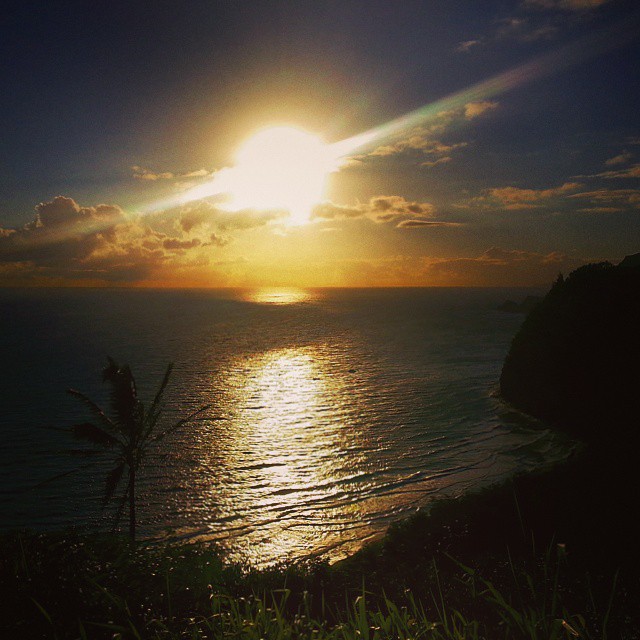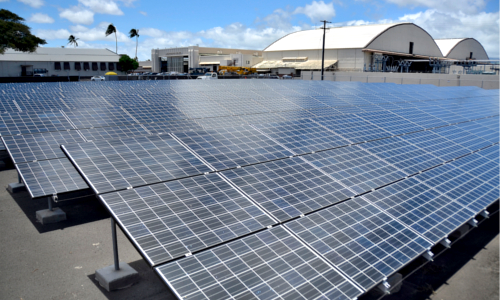
Written by Bentham Paulos
Editor’s Note: The Green Divas recently visited Hawai’i Island (The Big Island of Hawaii), where we visited Friends of NELHA, a nonprofit, charitable organization. It was fascinating to learn about the development of renewable energy resources and uses of cold deep seawater and warm surface sea water in innovative aquaculture and mariculture activities. According to Friends of NELHA, the state of Hawaii, as a whole, achieved about 18.2 percent renewables in 2013, while Hawai’i Island renewable resources for electricity amounted to 40.5 percent!
Listen to this Green Divas myEARTH360 Report to learn more, then read on for an excellent article from our friends at EcoWatch!
Written by Bentham Paulos
From an energy perspective, Hawaii is unique.
Located in the middle of the Pacific, the Aloha State runs on imported oil. But its island environment—from sunny days to active volcanoes—also holds the keys to a future powered by renewable energy.
Oil powers Hawaii’s cars, trucks, planes and boats, and generates 72 percent of the state’s electricity as well. Importing all that oil costs $4.5 billion each year. That’s $3,200 for every man, woman, and child—every cent of it leaving the state to pay for oil. And thanks to its dependence on oil, Hawaii has by far the highest electricity prices in the U.S., averaging 34 cents per kilowatt-hour—three times the U.S. average.
But this has also been a catalyst for change, and Hawaii’s energy picture is changing fast. Hawaii is a living laboratory for best practices in the integration of renewable energy into the smart grid of the future.
“We are seeing game-changing advances in technology and increasing customer demand for control over their energy usage,” said PUC Commissioner Lorraine Akiba. “It is transforming the electric industry here in Hawaii and all over the country.”

Hawaii first set renewable energy goals in 2001, later making them mandatory and expanding them. Revisions made in 2009 require utilities to meet get 70 percent of their supply from clean energy by 2030, with 40 percent from renewable energy and 30 percent from energy efficiency.
The state has also offered tax incentives for wind and solar energy wind since 1976.
These policies, combined with the declining cost of renewables, have triggered explosive growth in recent years. In 2013 alone, customers of Hawaiian Electric (HECO) installed over 129 megawatts of solar panels on Oahu, Maui and the Big Island, boosting the total to 300 megawatts from over 40,000 systems.
To put that in perspective, HECO has only 2,400 megawatts of firm power capacity. Fully 10 percent of the utility’s customers on Oahu have solar. With this growth, Hawaii is now a national leader in solar power per capita.
Such a density of solar is causing problems for the distribution grid. A distribution circuit may feed hundreds of customers in a neighborhood, stepping the power down from the higher voltage transmission system. This is traditionally a one-way trip, from power plant to customer. But there are times now in Hawaii when solar systems on a distribution circuit will produce more than the power demand on that circuit, causing the surplus power to flow backward into the higher-voltage system.
According to GTM Research, 40 percent of the circuits on Oahu are at or near full capacity. HECO has begun requiring that studies and grid upgrades be paid for by customers installing solar on circuits that may max out their circuits. This has caused a backlog for new permits, frustrating solar companies and slowing down installations.
Help may be on the way, however. Legislation in 2012 gave the state PUC the authority to create the Hawaii Electricity Reliability Authority (HERA), a third-party contractor that would “monitor, enforce and analyze” reliability standards and interconnection agreements. While the utility will continue to control the grid, HERA will “take a greater role in the oversight” of distributed generation.
The development is welcomed by state energy director Mark Glick. HERA “will allow for an objective third party to make the assessments of what can be safely and reliably entered into the grid,” he said. But the PUC must still determine “to what extent and whether it’s an oversight or direct role.”
While the PUC rules are expected soon, pressure from the solar industry is pushing the issue. The Grid Modernization Act, HB 1943, would guarantee that “any person, business, or entity can make a safe and reliable interconnection on the Hawaii electric system in a timely manner and for a reasonable cost” regardless of location. Grid upgrade costs would be shared across the system.
The bill has drawn opposition from HECO and the state consumer advocate over the costs to non-solar customers, while the PUC expressed “strong concerns.”
“Distributed generation, as currently priced, lowers costs for the few and increases costs for the many,” testified Scott Seu of Hawaiian Electric.
The bill sponsor is the chair of the House Energy and Environment committee, Rep. Chris Lee. His committee passed the bill in late January in a 7-3 vote.
“I think it’s in the utility’s own interest to make changes themselves to their business model—to be a 21st century distributor of electricity so they can continue to thrive—but they’re going to have to adapt in the face of new technology,” said Lee at the hearing. “If they’re not going to move there themselves, we have to help make sure they do, because we need a viable utility with a sound business model.”
The bill is slated for the House Committee on Finance tomorrow and faced the Consumer Protection and Commerce committee on Feb. 12.

Serious business
Replacing oil with renewable energy is serious business. Citizens invested $471 million in solar alone in 2012, supporting 71 solar companies that employ 1,600 people. Solar accounts for 26 percent of all construction activity in the state.
“We really see this as being a huge, important addendum to our economic activity and growth in the future,” said Glick. “We’re highly dependent on tourism and defense. We see energy being a much bigger, growing sector. Our renewable energy agenda really pushes us in that direction, basically a home-grown industry.”
Being so dependent on oil, Hawaii’s economy is at the mercy of global geopolitical events. When oil prices shot up in 2008, “over $1 billion left our economy, with no value added whatsoever,” said Glick.
In addition to solar, Hawaii is blessed with every form of renewable energy. Wind, geothermal, and solid waste together provide 10 percent of power, with more from biomass and hydro. The Big Island is already 40 percent renewable.
The island of Kauai is especially aggressive on solar. The national Solar Electric Power Association (SEPA) recently named David Bissell, CEO of Kauai Island Utility Cooperative (KIUC), as the Utility CEO of the Year. Bissell has helped Kauai become a “laboratory for innovation in engineering and utility finance” in pursuing utility-scale solar projects.
The community-owned utility has a goal of 50 percent renewable power by 2023. It has been actively adapting its system to work with more renewables and less oil. Kauai has wireless smart meters for nearly all of its 33,000 customers, online customer usage data, and utility-scale battery systems to provide more reliability and smooth out fluctuations. These batteries have prevented blackouts when oil-fired generators have tripped offline.
To reach its renewables goals, the utility is building more small hydro systems, a biomass power plant, and interconnecting more solar—including over 600 small solar systems in the past two years and 30 megawatts from three big projects now under construction. When these projects are done in 2014, Kauai will meet half its daytime power demand from the sun. With so much solar coming, the utility is thinking of “offering rates to encourage customers to use electricity during the day, when power is being produced more cheaply,” such as for charging electric cars.
Growing pressure for change
Kauai is in the vanguard of a global trend toward the greater use of solar power, as documented in America’s Power Plan, a recent report from the Energy Foundation. Regions like Germany, Spain and California are seeing disruptions to their traditional electricity markets, regulations and business models. As solar becomes competitive with grid power, more customers are producing their own, eroding utility profits. And an abundance of daytime solar power is driving down wholesale prices and shifting peak demand to early evening, changing the operations and revenues of generators.
The report calls for reforms to regulations and business practices to facilitate the transition to more renewables, such as by making sure electricity rates reflect the costs and benefits of solar, cover the cost of maintaining the grid and encourage efficiency.
Hawaiian Electric is pursuing more renewables, but the Public Utility Commission is also forcing it to innovate with new utility business models that can adapt to changing times. In a recent case, the PUC issued an extraordinary statement that “the HECO Companies appear to lack movement to a sustainable business model to address technological advancements and increasing customer expectations.”
“Electric customers are increasingly frustrated because of high electric rates,” the commissioners wrote. “The commission affirms its commitment and support of Hawaii’s clean energy transformation. However, clean energy in and of itself is not the singular goal but rather should be viewed as one strategy to serve the public interest, along with sound business practices centered on customer value.”
“The utility of the future is one that will use innovative technology to provide cost-effective service and value to customers,” added Commissioner Akiba. “That means renewables, storage, electric vehicles, and demand-side management tools. It doesn’t have to be a threat to utilities, if they would just embrace it.”
In the long run, the state energy office says Hawaii has the potential to produce more than 140 percent of current power demand from renewables. Geothermal energy on the volcanically active Big Island would be the backbone, supplemented by wind, solar and biomass plants across all the islands. To integrate the system, Hawaii has begun planning for an inter-island undersea power cable, the first to link the islands.
Existing oil-fired power plants will be maintained to ensure reliability, but with renewables rising, they will use dramatically less oil. Hawaii is finding ways to turn off the tap, tune in to its natural resources, and turn on the lights with renewable power.
Bonus:
Listen to the latest Green Divas Radio Show….
[dynamic-sidebar id=’Custom Widget 2′]
Pingback: Renewable Energy... Hawaii Style - myEARTH360 (the blog)
tim
December 3, 2015 at 4:48 am
It only makes sense that Hawaii is a leader in solar energy along with California. Incentives from the state is so important to make it available for the common household. I live in Florida, and it has been a nightmare with getting help from the state and utility companies on providing solar. Things are changing though with reforms.
Great article!